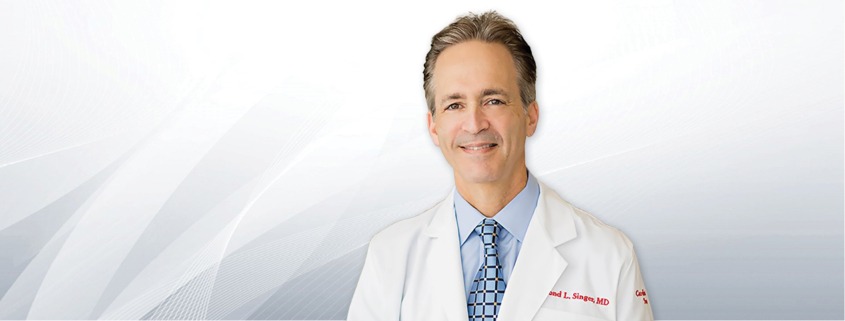Testimonial – Dr. Raymond Singer
Utilizing Next-Generation Vision-Aid Products for the Ergonomic Practice of Surgery
An Interview with Dr. Raymond Singer
A written interview requested and directed by B. Jin Chang, PhD, President of SurgiTel / General Scientific Corporation, with Raymond Singer, MD, MMM, CPE, FACS, FACC, FCCP.
Dr. Singer, before I begin the interview, I would like to summarize our initial meeting for some background. I met you during the 1999 AATS (American Academy for Thoracic Surgery) meeting and you told me that you had been experiencing serious neck pain. So I asked you about the loupes you had been using. Your answer was that, like most other surgeons, you started your surgical career using traditional Through-The-Lens (TTL) loupes by Designs for Vision. I explained why I started to design ergonomic loupes and suggested you try one of our Front-Lens-Mounted (FLM) loupes with an adjustable declination angle so you could customize your angle and optimize your neck posture. You bought one of the 1st generations of our ergonomic loupes and soon added a loupe-mountable fiber optic light to your loupes. During the 2000 AATS meeting, you looked for me at our booth and told me that your neck pain had disappeared. To help clinicians (dental professionals and surgeons) work with a safe and comfortable neck posture has always been the main design objective of SurgiTel loupes.
Q: What sort of ergonomic education did you receive during your schooling?
A: Unfortunately, none… period. In fact, I herniated a cervical disc during my cardiothoracic fellowship training and never even got the proper treatment. A neurosurgeon at the time attributed my back pain to a thoracic spine problem, completely missing that I had a C-5-6 and C-6-7 herniation. As a result, I never got the needed rest (and perhaps surgery) and have been living with chronic trigger point pain for the past 25 years. My neck and back pain has been a large worry for me. The fact that the SurgiTel loupes allow me to stand more erect with less weight on my neck has been a career saver.
Q: How did you decide on the type for your first pair of loupes?
A: Like everything else in surgery, it’s “see one, do one, teach one.” The senior residents and attending told us what loupes to buy. For all I knew at the time, there was only one choice (Designs for Vision). I never knew there were choices.
Q: What made you decide you needed to change your loupes?
A: I was at the AATS meeting in Boston one year and met you, Dr. Chang. I described my neck and back problems and I was enlightened on a host of ergonomic issues in the operating room. By the way, not just posture but also room lighting, color contrast, et cetera.
Q: How long did it take for you to feel a difference between your traditional TTL loupes and your SurgiTel, next-generation ergonomic FLM loupes?
A: Immediately. Everything changed immediately. I had no pain after a long case. My eyes were more relaxed as well and I could see better.
Q: You replaced traditional, heavy headband-mounted fiber optic lights with next-generation, lightweight loupe-mounted fiber optic lights. What are the major benefits of loupe-mounted headlights over headband-mounted headlights for your practice?
A: Among other things Dr. Chang, you showed me that we all use too much light in the operating room. A simple maneuver of turning down the ambient room light immediately increases the brightness on the field. Of late, I actually turn off the spotlights and only use my loupe mounted light. In this instance, for the assistant when you turn your head away of course the field gets dark for them but it is unlikely they need to do any fine assisting when the surgeon isn’t directing his light in the field. An alternative here would be to have the assistant use his/her own headlight but again, less light is actually better.
Q: You found that traditional overhead lights in the OR were too bright, but many surgeons (as well as dentists) may believe that brighter illumination is better. The traditional overhead lights usually brightly illuminate surgeons’ heads, but photos of you working show there is no light being wasted, illuminating what you can’t see. Can you share how you optimized the illumination of overhead lights?
A: As above, I often turn off the overhead light. For one thing, it drops the temperature at the field considerably. This makes me more comfortable because I am not as warm but also protects the surface of the right ventricle of the heart which can be a significant risk during long cases. My eyes are less tired at the end of a case, I have lost less fluid from heat, and I am more relaxed… all of this matters for the surgeon, the assistants, and of course the patient. A comfortable surgeon makes for a better case all around.
Q: It is difficult to teach ergonomic practice because posture-related pain and injury is often only developed after years practicing with bad postures. How are you teaching your residents about the value of ergonomics?
A: I am constantly preaching the benefits of good posture, better eye protection, and better lighting. One thing you have not touched on in this interview is eye protection. Many cardiovascular surgeons are doing more procedures using fluoroscopy, e.g. TAVR, TEVAR, EVAR, et cetera. Radiation causes early cataracts. It is a known phenomenon and I believe we are going to see an epidemic of 50-something-year-old surgeons in about 10-15 years all developing cataracts. ALL surgical loupes should be lead-lined protected.
[Note: X-Ray protection options are available for SurgiTel FLM loupes.]
Q: Some are describing work-related injury caused by non-ergonomic loupes as an epidemic. What have you seen in your field and among your peers?
A: All surgeons eventually develop neck and back pain. While not 100% is due to the loupes, the fact is that 100% is due to the long hours, stress, and posture. To the extent that the SurgiTel loupes correct so many issues (weight, posture, lighting), the proper loupes setup can make a huge difference to the majority of surgeons. In my case, it took away 90% of my back issues and allowed me to have a long career, performing over 200 heart procedures per year with no residents or fellows, meaning I am in every case “skin-to-skin.” That is a lot of work, but I have been able to manage due to the many advantages of the SurgiTel loupes and the teachings of ergonomics by you Dr. Chang.
Q: You have been using the SurgiCam, a loupe-mounted digital video camera. Would you share the benefits you have experienced from using the SurgiCam?
A: Everyone loves to come to watch open-heart procedures. We mounted a huge 70-inch flat-screen TV on the wall in my O.R. to show the streaming video from my SurgiCam and students can come and watch without having to stand looking over the drapes. I have a personal website (www.heartlungdoc.com) that features dozens of my videos. It has also been a great advantage for talks and presentations, Grand rounds, and community events. It has not only enhanced the academic side of my practice but it has literally increased referrals because both the patients and the referring physicians love the videos. I can literally send a video of a mitral valve repair to the referring physician. Imagine the referring physician receiving a follow-up letter with a disc of the actual operation!
Q: What has made you decide to experiment so much with your equipment and practices when doing the same as your peers would probably be considered enough by many people?
A: I can’t help but smile when I see a question like this one. I do not know what has driven me to be the best my entire life. I am competitive and I love to work hard. Working hard is not a chore for me. I always want to push the limit because what we do really matters… and quite frankly, it’s fun. I started my educational website for patients in 1999.
Think about that for a moment – a personal website in 1999! In those days there were no two-way cable modems, everything was done over a phone line. I can remember it taking 45 minutes to load a single photograph onto my site. (Of course, there would often be an interruption in the line about 30 minutes into it and I would have to start over again.) The software was pathetic and the computers back then had less memory than my current iPhone. But I persevered and now I receive hundreds of hits per day and considering I am not at a university program, I still get patients from all over the country.
After 23 years in practice though, I believe I have learned to be more prudent in my approach to new technologies. As a young surgeon, we often rush in, not wanting to be left behind. Now I do a little more research and I am more conservative, though still pushing hard to improve. At the end of the day there is a lot more to medicine than just science. I have always understood the importance of new technologies, measuring quality outcomes, marketing, and costs. Only recently with healthcare reform is the rest of the country catching up with those of us who “got it” for years.


